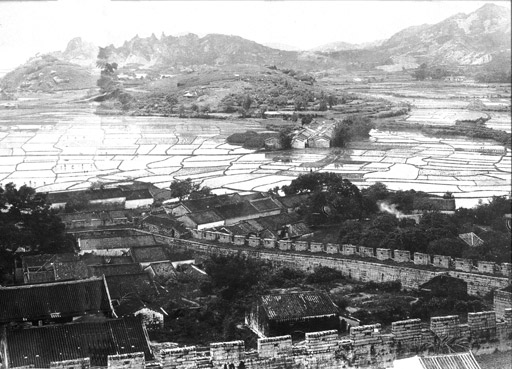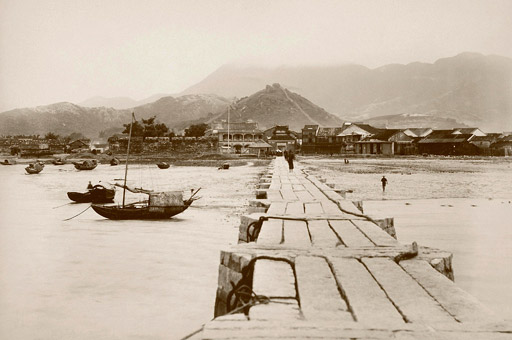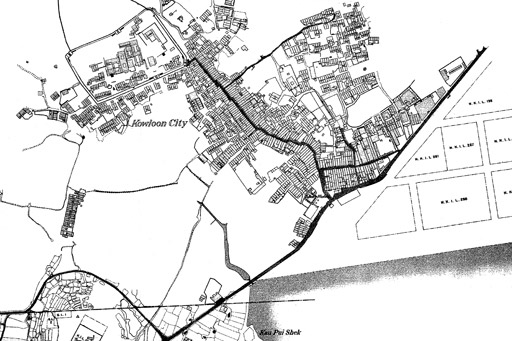SETTING THE SCENE

The Walled City seen from White Crane Hill in 1865.
The root of the Walled City’s curious legal status can be traced back to the 1898 Treaty of Peking that ceded the land that came to be known as the New Territories to the British on a 99-year lease. From the Chinese perspective, this was yet another unequal treaty that was being forced upon them, but they were unwilling to give in without a fight and they demanded that the military and magistrate’s compound, known in English rather misleadingly as Kowloon Walled City, which stood at the foot of White Crane Hill overlooking Kowloon Bay and neighbouring Kowloon City should remain Chinese Territory.
Rather grudgingly the British, wanting to settle the matter as quickly as possible, agreed to include a clause stating that “within the city of Kowloon, the Chinese officials now stationed there shall continue to exercise jurisdiction except so far as may be inconsistent with the military requirement to the defence of Hong Kong”. It was a gloriously vague phrase and within a year, when the Chinese garrison in the Walled City was reinforced by a further 600 troops in response to fierce resistance to British rule in the New Territories, the Hong Kong government decided enough was enough and marched on the City only to find it already deserted. To validate the situation, an Order-in-Council was issued in December 1899, announcing British jurisdiction over the Walled City, but as a unilateral revision to the Treaty it was never recognised by the Chinese.

Lung Chun Pier and the ceremonial entrance to Kowloon City in 1898.
In reality, little of this mattered. The Walled City was now a deserted compound deep in the New Territories’ countryside, then a long way from the built-up areas to the south on the Kowloon Peninsula. And with the Chinese government largely in turmoil over the next 40 years, the Hong Kong authorities felt they could do with the Walled City as they wished, to the extent that in the 1930s they evicted the pig farmers who had taken the place over and turned it into a tourist spot. But all was about to change.
The Japanese invasion of Hong Kong in December 1941 and the subsequent occupation, unsurprisingly, affected all of Hong Kong badly, but the impact was especially notable around Kowloon City. The part of Kowloon Bay which Kowloon City once overlooked had been reclaimed in 1923 as part of a failed business venture, the Hong Kong government taking back control of the land in 1925 and establishing Kai Tak Airport. Expansion of the airport in the 1930s had begun to change the area, but when the Japanese took over Kai Tak as its military airfield in 1941, the rate of change escalated rapidly.

The Walled City and Kowloon City in 1924, shortly after completion of the reclamation that was to become Kai Tak Airport.
A good part of old Kowloon City overlooking the airport was demolished and the walls of the Walled City were torn down for use as building material during the airport’s subsequent expansion. Allied bombing caused yet more damage, virtually obliterating what was left of old Kowloon City, though somehow sparing the few old Walled City buildings that still existed. And so it remained, the rubble left by the fighting providing handy building material as those Hong Kong residents displaced during the War began to return to Hong Kong at the end of 1945, quickly followed by the first of the refugees fleeing the civil war in China.
The situation for the Hong Kong authorities was now extremely complicated. Efforts were made to start rebuilding Kowloon City in a new area to the west of its old location, around a grid of streets that remain to this day, but the demand for shelter far outstripped supply and squatter settlements began to spring up all over the hills at the back of Kowloon and more importantly around and within Kowloon Walled City.
Fearing they might lose control of the area, in 1947 the authorities took the unprecedented step of trying to deter building on the Walled City site itself and evict those who had already moved into the area, but the operation was badly handled, resulting in significant resistance. More importantly, it also provoked rioting across the border in Canton (Guangzhou), with the British Mission there being set on fire. The Chinese government voiced it strongest objection to this unwanted action on Chinese soil, and the Hong Kong authorities were forced to withdraw its plans and leave the City to its own devices.
Despite the 1899 Order-in-Council claiming British jurisdiction over the area, it was clear that the Walled City would henceforward be subject to dual jurisdiction, with all the uncertainties and restrictions that would entail. Even so, few at that time could imagine just how quickly this situation would take over every aspect of the Walled City’s growth and development in the years to come.
